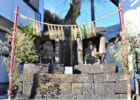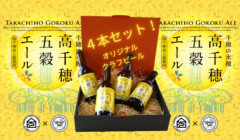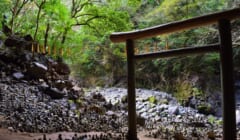
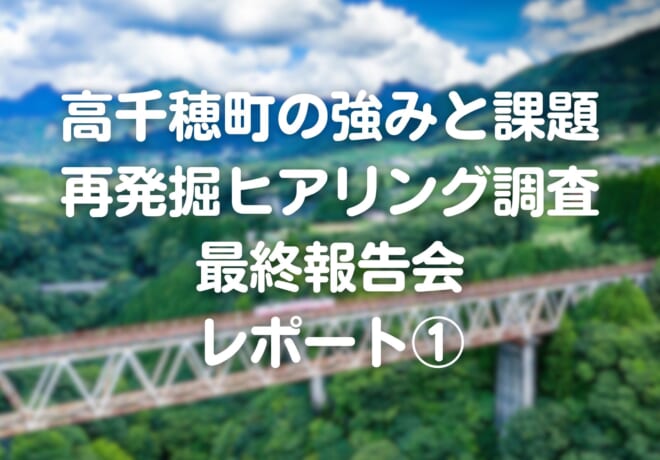
Living, Protecting and Building the Future, a survey conclusion on Rediscovering the Strengths and Challenges of Takachiho Town part 1
- 0 お気に入り
- 719 view
- お気に入り登録

What do you know about Takachiho?
You may be familiar with the famous tourist attractions such as Takachiho Shrine and Takachiho Gorge. However, there is a wealth of other attractive local resources.
Takachiho is surrounded by mountains and has a unique topography with beautiful terraced rice fields, a traditional agriculture and forestry, as well as a culture that has been handed down from generations back, while maintained by the strong ties of the community. Living in the area itself has been recognised as a World Agricultural Heritage Site and this in itself a proud local resource of Takachiho.
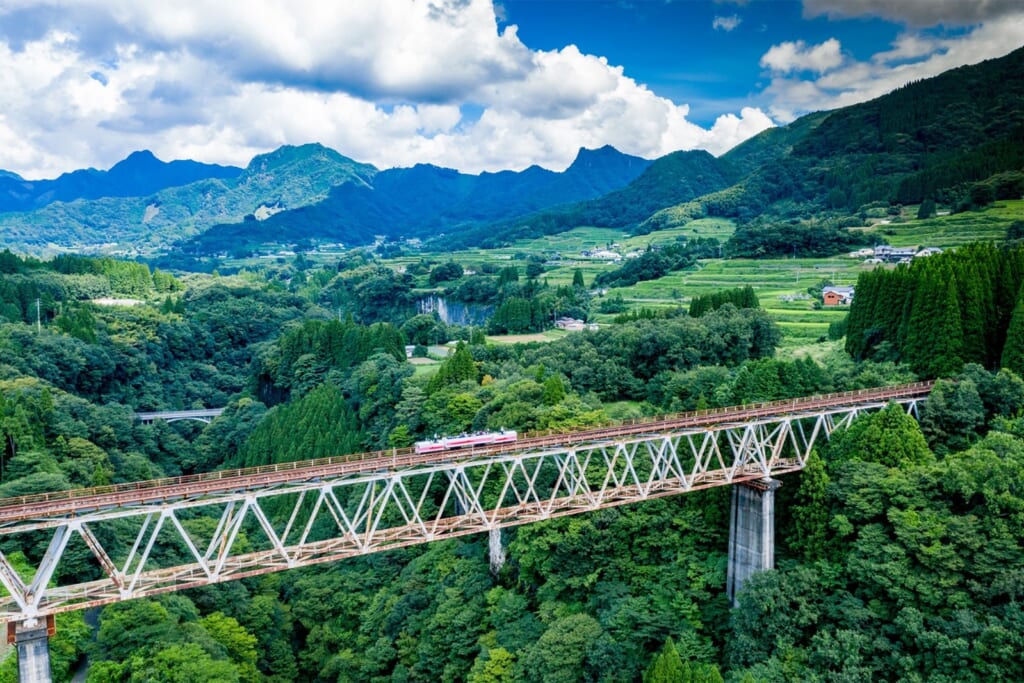
However, due to population decline and the ageing of the population, the resources such as people, goods, money and so on, that lets the town to sustain the nature, landscape, livelihoods and lifestyle that is Takachiho, is gradually disappearing.
In order for Takachiho to be able to promote a sustainable town development, the citizens must work together to solve the challenges. This by utilising its abundant local resources and finding new values through dialogue between the various industries.
Therefore, it is necessary to identify the strengths as well as the challenges Takachiho possess!
In order to rediscover the local resources and identifying the strengths and challenges, a interview survey was conducted with 100 people in the town. As a report on the results, a concluding meeting regarding the interview survey was held.
Here we will introduce you to a four-part series of research reports, town case study presentations and group discussions that took place during the meeting.
Report on the concluding meeting of the interview survey to rediscover the strengths and challenges of Takachiho Town, part 1
On May 12th 2023, the town of Takachiho hosted the ‘Takachiho Town Strengths and Challenges Rediscovered! A concluded information meeting of the interview survey’. This meeting was part of Takachiho’s efforts to promote its sustainable town development. It was attended by 55 people from various industries, relevant organisations and Takachiho high school students.
Overview of the event
Date and time: 12 May 2023 (Friday) 13:30-15:45
Place: Nature Recreation Village Management Centre (自然休養村管理センター)
Number of participants: 55
■ Part 1: The Results of the interview survey
- Reported on by Ai Sato from DHE Corp.
An analysis of common topics and keywords in the interviews by frequency of occurrence and by components were made. It was presented that there are possibilities to combine the improvement of local resources with tourism, and that cooperation within the region for a common purpose will lead to new clues on solving the challenges Takachiho is facing.
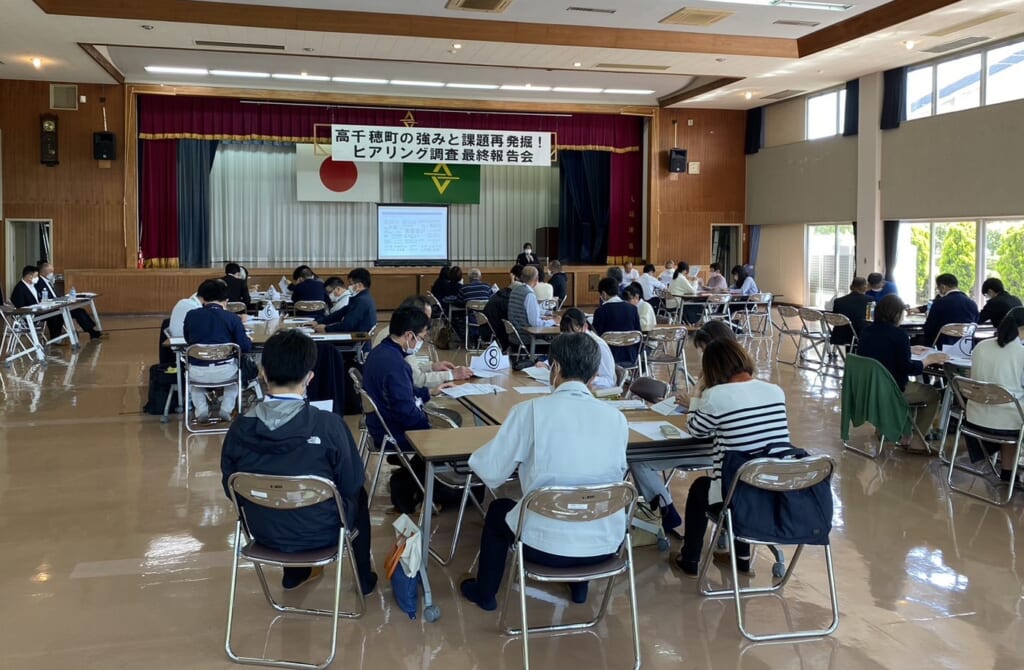
(1) Survey outline
■Subjects of the survey
Organisations, businesses and others active parties in the town.
■Survey method
Interviews
■Time period
July 2022 – March 2023
■Survey implementation
100 people (divided as below)
- Commerce and industry, tourism organisations (7), tourism services (10), accommodations (4), transport services (1), shrines (1), agricultural support groups (6), farmers (agricultural production 4), farmers (livestock production 4), sixth industry(6次化事業agricultural, livestock and marine products, food processing, distribution and sales 4), community farmers (3), forestry/forestry support organisations (3), avian/veterinary organisations (1), meat processors (gibier) (1), restaurateurs (6), food wholesalers (1), food manufacturers and distributors (4), real estate agent (1), retailers (5), LP gas retailer (1), rice millers (3), service providers (3), construction trade associations (1), construction companies (4), nature conservation organisations (2), mountain associations (1), education-related groups (5), government-related organisations (2), social welfare (2), town councillor (1), community development projects (2), community development cooperatives (2), housewives (4) and volunteer workers (1).
(2) Strengths and Challenges based on frequency of occurrence
The participants answers regarding strengths and challenges were summarised during the interviews. This by common topics and keywords and frequency of occurrence. As a presentation it can be seen visually below. The more frequently a topic appeared during the interviews, the larger it is displayed in the presentation.
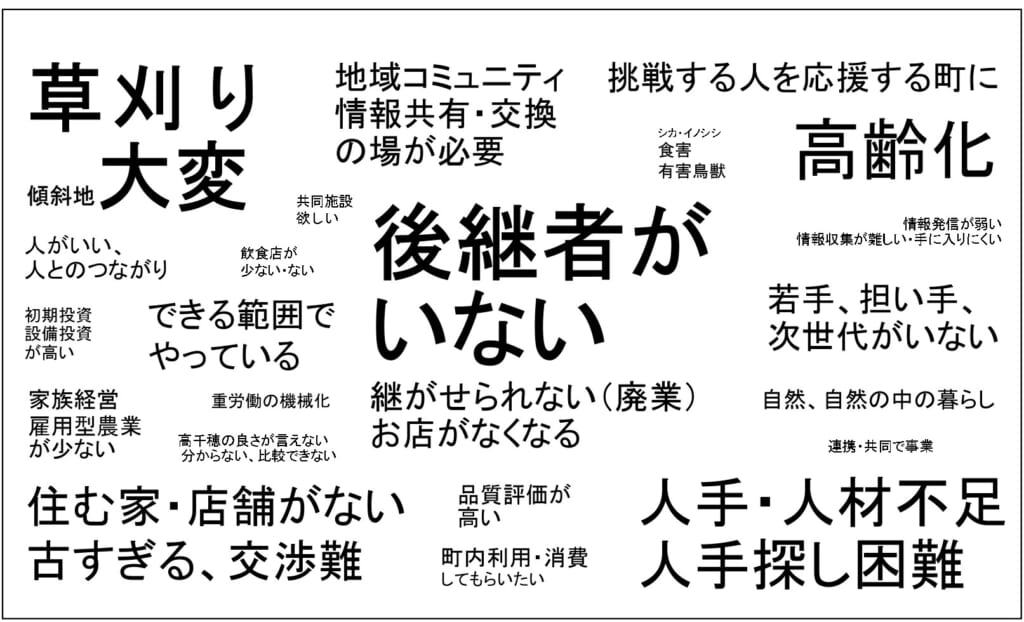
- The most frequently occurring answer was ‘No successor’.
- Both in the agricultural and commercial sector, interviewees answered that there was no one to take over the business, or that the tough business environment made it difficult for possible successors to take over. Many people said they would cease business during their own generation, which is a major issue.
- Next in order was ‘Mowing is hard’, with the second highest number of occurrences. This was followed by ‘ageing population’ and ‘lack of human resources’.
(3) Classification by categories
The topics where then classified into five different categories (challenges, requests, situation, solutions and strengths).

Let us have a closer look at it visually.
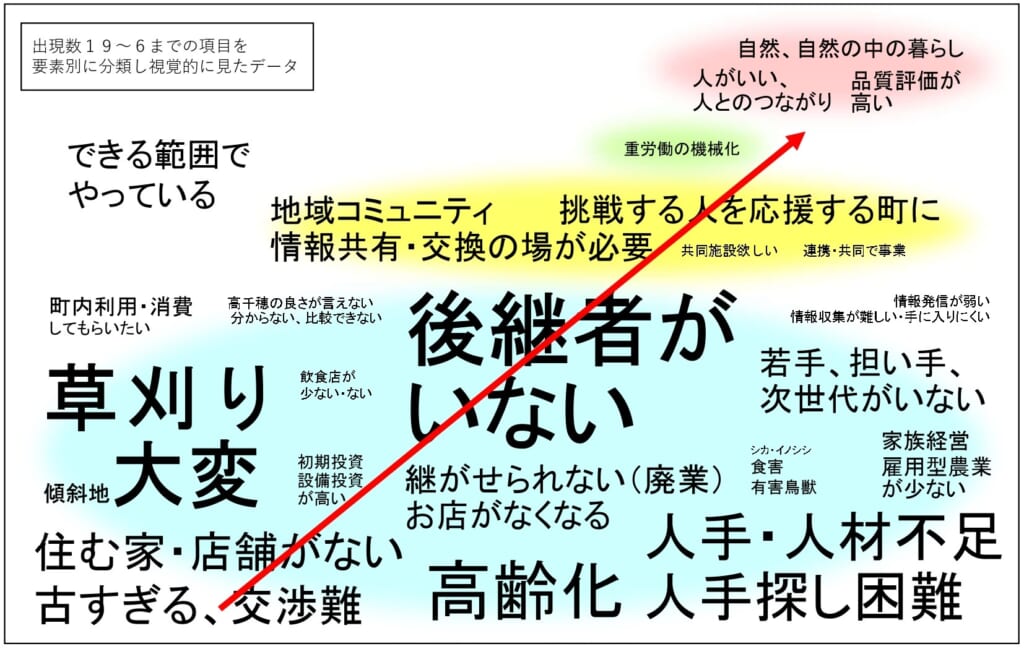
From the visuals we can see that, ‘Challenges/problem/perceived to be a problem in the future’, is the greatest category in both frequency and in numbers.
In response there were a relatively high number of requests and ideas on how to address these challenges. The fact that a lot of people want to do something together, such as collaborate, cooperate or exchange information where seen across the results.
(4) Summary of survey results
Based on the results, the survey findings are summarised below.
■ The decline in the towns ‘driving forces’ is a common perception of a challenge
- Even before the survey the interviewees had identified the reasons and cause of the decline of ‘driving forces’ in the town. For example ‘lack of successors’, ‘lack of leaders’ and ‘ageing of the population’ were presented as reasons.
■ Difficulties in maintaining a lifestyle surrounded by nature
- While some argue that ‘nature/living surrounded by nature’ is a strength, it is becoming increasingly difficult to maintain.
- In particular, “weed mowing” was an challenge raised not only by farmers but also by many others. Due to the unique topography of Takachiho, the slopes are high and steep, and require a lot of effort to maintain. The slopes makes it difficult to use machines. Forcing them to do it by hand is one of the reasons why elderly farmers have had to give up their farmland.
■Inhabitable homes and the challenges of empty houses
- Due to labour shortage, many businesses are looking to attract employment from outside the town. However the lack of proper housing was raised as a challenge.
- While there are many houses that are vacant, a lot of the times the landlords cannot be contacted, or do not wish to give up the houses. This resulting in many of the houses being in uninhabitable conditions by the time they become available. Rental properties are also expensive, resulting in rental costs taking up a large proportion of total income. There are also people who want to move to Takachiho and take on new challenges, such as starting a farm, but there are problems with being accepted immediately.
■ The establishment of local brands
- While many local products such as wagyu beef, vegetables and timber have a great reputation for quality even outside of Takachiho, it was observed that the development of products and creating new Takachiho brands using local resources has not been going well.
■ A cooperate information exchange forum for solving the towns challenges
- It is concluded that there is little cooperation and joint projects in town. The situation appears to be that each individual is making efforts to address their own projects and challenges. With the ageing of the population and the shortage of staff and leaders, there are many challenged that can’t be solved by individuals or single establishments alone, which is why many asked for a forum for sharing and exchanging information for cooperation and collaboration within Takachiho.
■ The need to strengthen information distribution
- As Takachiho is a well-known tourist destination, the town has the advantage of attracting tourists without any information distribution or PR efforts. However, apart from the major tourist attractions, there is little information on places to visit or eat that can be collected in advance, which tourists often asks about.
- Many felt that this topic was a crisis, saying that the number of tourists would not last if the situation was left unchecked.
- Within the town, many people answered that it was difficult to gather information on rentals and job vacancies. This due to much of this information not being available on the internet.
■ Become a town that encourages people to challenge
- Many felt that there was a negative or critical attitude towards new projects and new initiatives in town, and with this expressed discontent and frustration. They wished that the town would encourage people to take on challenges.
■ The appeal of each village
- Each village within Takachiho have a different landscape, shrines, history and culture unique to the respective villages. The famous night kagura of Takachiho has different dance styles in each village, which is said to reflect the beliefs of life in the past. These different areas function using system to maintain the village by the community itself, which in return creates a strong community formed by self-effort and mutual cooperation.
■Takachiho’s strengths and favourite aspects = What we want to protect
- Many answered that ‘nature, living in nature’ and ‘good people, connections with people’ were the strengths and favourite aspects of Takachiho. On the other hand, many also voiced that they were unaware of Takachiho’s strengths, suggesting a situation where they liked Takachiho but were unable to concretise it.
- The ‘good aspects’ and ‘favourite aspects’ were also linked to the ‘things we want to protect’ and ‘things we want to preserve’. Since the ‘driving forces’ of the town is limited, identifying these keywords where important in order to determine what is to be protected and preserved.
Improving local resources
- There is good potential for refining local resources into new value-generating resource. This by matching them with the needs of tourists, resulting in a ability to resolve local challenges related to relationships, people coming from outside of town, job creation and foreign currency earnings.
- The JTB Research Institute, which conducts surveys and research as a think-tank specialising in tourism, has published the results of its ‘Evolving and Expanding Areas of Japanese Domestic Travel’-report, which states that there is a noticeable shift from conventional sightseeing that visits tourist spots, to tourism with a purpose that allows people to ‘experience’ and ‘learn’ things unique to that region. We believe that matching the local resources of Takachiho to these needs is a promising approach.
Based on the results of the survey, we have taken steps to improve local resources in order to resolve our challenges.
- ‘Local resources’ x ‘Challenges’ x ‘Lifestyle’
- In the area of refining sustainable local resources, we organised a monitoring tour with a menu of experiences that combined ‘local resources’, ‘challenges’ and ‘lifestyle’.
- This experience program was designed to share local issues with the participants, allowing then to get in involved with the challenged areas adressed in the program.

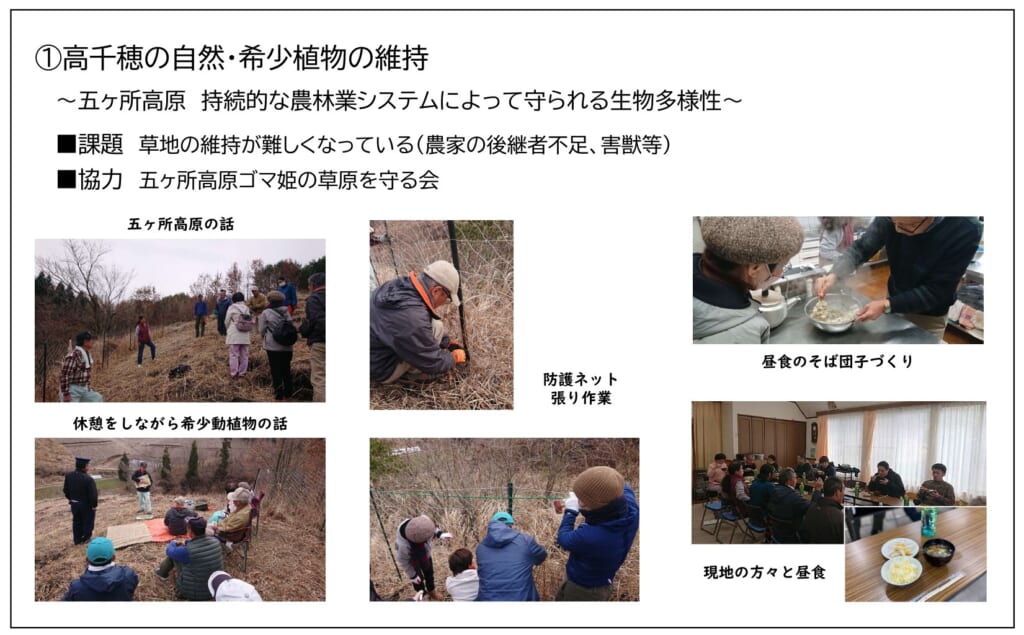
This tour was conducted on the Gokasho Plateau, where the participants worked on deer protecting nets and interacting with locals.
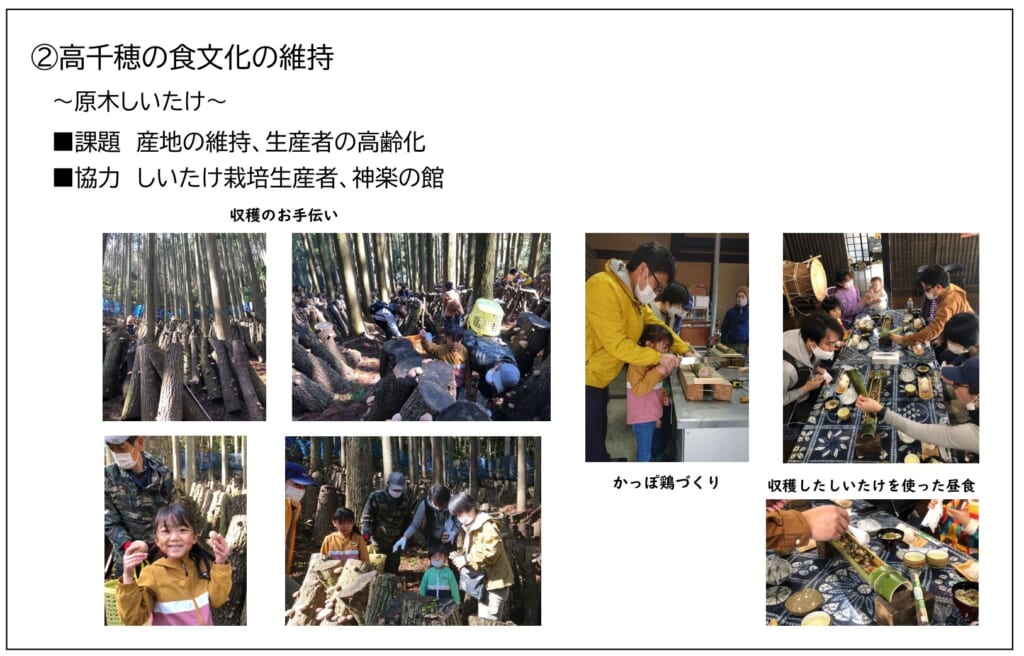
These are log shiitake mushrooms. The participants were able to help out at a cultivation site where the farmer normally works alone.
- From the monitoring tour:
- ‘I didn’t know until I came on site’, ‘There are so many things you won’t know unless you come onto the field yourself’, were expressed by the participants. The experience of visiting local people in the field was something that could not be experienced in everyday life. This fact resulted in an increased level of excitement and experience value for the participants.
- In addition, by sharing local issues, a sense of responsibility for the task of “helping with the hard work”, rather than just simply “experiencing it” was formed. All resulting in creating of a purpose for revisiting Takachiho, such as “I want to help with other tasks” or “I want to come back in a different season”.
Conclusion – Working towards a solution to the challenges
- Takachiho has seasonal differences in terms of natural changes and agricultural activities, as well as differences in scenery in of its each regions. Every region have shrines, history and culture that are unique to the area. Therefore, we believe that there is still a wealth of local resources that can be matched to the needs of tourists. We can conclude that even local challenges can be combined with tourism to become new local resources for communicating the town’s appealing asets.
- Turn the locals ‘normal’ into ‘value’.
- Why not try to find ‘something’ to refine?
- The knowledge and cooperation among the locals is essential to meet the diversity of needs facing Takachiho!
- Various local industries collaborating across boundaries and adding the perspectives of their respective industries and abilities as local residents, will result in ‘valuable tourism with a variety of experiences’.
These initiatives will result in:
- ➡Creation of new flows of people from Japan and abroad.
- ➡Cooperation provides new clues to solving the challenges the town is facing.
Let us create a sustainable town by getting as many townspeople as possible involved, while contributing to solving the various challenges faced by the community!
 関連の記事
関連の記事
 コンシェルジュからのおすすめ
コンシェルジュからのおすすめ
お客様のご要望に沿ったおすすめの観光情報・宿(ホテル 旅館)・レストラン・居酒屋・カフェ・ショップ等をコンシェルジュスタッフが厳選してご紹介しております。






